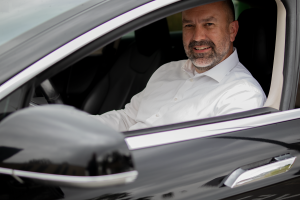Power Moves Go Profile: Andrew Horstman
 What is your electric vehicle’s make and model?
What is your electric vehicle’s make and model?
I have a 2015 Tesla Model S 85D
Why did you purchase an electric vehicle (EV), and how did you decide on your particular vehicle?
In 2019 I purchased my Tesla used from a dealer in Chicago that specializes in used EVs. I did my research on available EVs and what sold me on the Tesla was the Tesla charging network; Tesla has the most charging stations in the state and throughout the country.
There’s a perception that electric vehicles are expensive. If you don’t mind sharing, how much did your EV cost? Did you receive any tax incentives to offset the price?
I purchased my Tesla for $43,000 and since it was used I did not receive any tax incentives. Insurance is higher for my car than a comparable internal combustion engine (ICE) car and there is an extra tax on the vehicle registration of $150 to cover the state’s lost revenue on gasoline tax. The higher purchase price, insurance and EV tax are offset by my fuel savings. My Tesla has lifetime free supercharging, so when I travel for my kids’ travel teams my fuel is free; there are a ton of free chargers as well at places like restaurants and hotels. I was spending around $150-$200 per month on gasoline prior to my EV purchase and now only spend around $20 per month on fuel.
What is your EV’s mile range, and how does that compare to your daily commute?
My daily commute is about 40 miles with an extra 10-15 miles added depending on where my kids need to be that night. My car has around 262 miles of range, 100% to 0%. My realistic range is around 200 miles; the EV battery doesn’t like to be charged over 90% unless it is needed and you typically don’t ever run the battery down to 0%. The range of my car when it was new was 270 miles, so in 6 years the car has lost 3% of its range. How you treat the battery will affect its health and longevity.
Where do you charge your vehicle the most? How long does it take to charge on an average day?
I charge at work and at home and this is split about 50/50. Charge time varies depending on the charger’s power and how low the battery is when you start. I don’t charge every day; I charge about every 2-4 days depending on my driving. On a Level 2 charger I can go from 10% to 90% in about 10 hours and the supercharger I can go from 10% to 90% in around 50-60 minutes.
Do you have difficulty finding public chargers when taking a road trip?
No, the Tesla onboard navigation will automatically route you through chargers and even calculates how long you will need to stop at each charger. We have taken our Tesla on plenty of road trips. Last year we drove to Gulf Shores for fall break and I drove all last winter for my daughter’s hockey games, as well as Cleveland, Chicago, Detroit and St Louis. There are also plenty of other tools available to find chargers; I use the PlugShare app and website a lot. It has all sorts of info about chargers on it.
What advice would you give to someone open to an EV but still a bit nervous about buying one?
Make sure the car fits your lifestyle; don’t buy a small EV if you need a mini-van or SUV, as this will taint your experience. If you decide to go with an EV embrace the difference and enjoy your charging stops. On our trip to Gulf Shores, every time we stopped someone in the car had to use the restroom, those restroom stops just lasted longer as the car was charging for 20 minutes or so. This gave us time to get out and walk around and get some food.
Say goodbye to gas stations! This summer my debit car got flagged for fraudulent use after I used it to put gas in my wife’s car; I realized I hadn’t used my debit card for gas in over a year and half. I even joked with my wife before I got out to pump the gas, “I hope I remember how to use this thing.